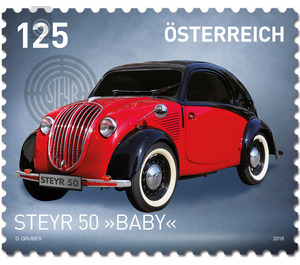cars - Austria / II. Republic of Austria 2018 - 125 Euro Cent
Theme: Science
| Country | Austria / II. Republic of Austria |
| Issue Date | 2018 |
| Face Value | 125.00 |
| Edition Issued | 130,000 |
| Stamp Type | Commemorative |
| Item Type | Stamp |
| Chronological Issue Number | 2709 |
| Chronological Chapter | OOS-OE2 |
| SID | 275611 |
| Dimensions | 35.00 x 42.00 |
| In 103 Wishlists | |
The car was developed by Ing. Karl Jenschke, who worked for the Steyr-Werke since 1922. Planning work for a flight engine - together with the engine designer Karl Wagner - finally led to the construction of a small water-cooled four-cylinder boxer engine as the basis for a small car. The Steyr 50 was manufactured by Steyr-Daimler-Puch from 1936 to 1938, then reworked and launched with a more powerful engine than Steyr 55 on the market. Of both variants, a total of 13,000 pieces were produced. The Steyr 50 cost 4,500 shillings, the 55s 5,000 shillings, which was not cheap at the time. In 1940, production was stopped due to the war. Small, but oh! The default was that the car should provide sufficient space for four people with luggage. Furthermore, he should be mountain suitable, which was also sufficiently proven during a test drive over the Katschberg. The necessary power was provided by the previously mentioned four-cylinder engine with 978 cubic centimeters of displacement and 22 hp at 3,800 revolutions; With its four-speed gearbox, the Steyr 50 achieved a top speed of 90 km / h. The streamlined, self-supporting body ensured a low dead weight with the greatest possible stability. The interior was spacious at that time, the rear passengers could comfortably board because of the large, rear-opening doors. The spare wheel in a separate spare wheel and a sunroof were already included in the standard equipment. The Steyr Baby was praised as a spacious, safe, powerful and practical car, especially his ability to drive on the steep alpine roads was highlighted. In addition, it was considered high quality, economical in consumption and low in conservation. A compact car as a full-size car - a real "Volkswagen" just, which is still a legend today.


